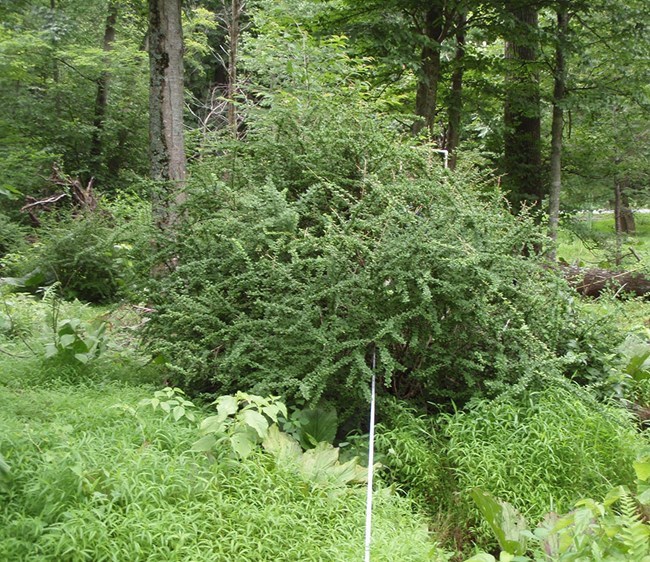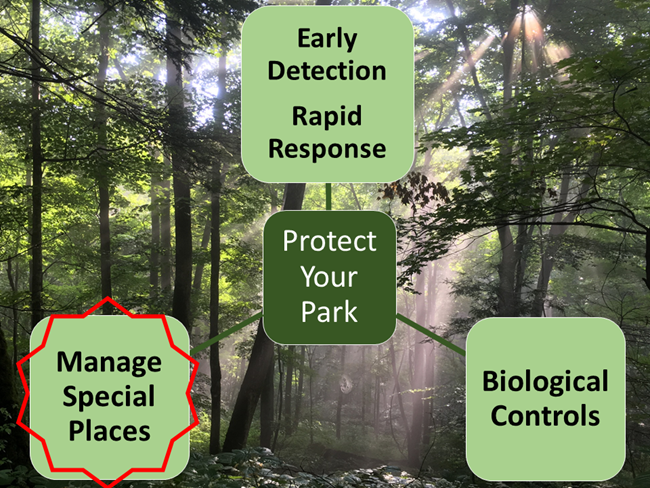
NPS
Have you ever noticed vines completely covering old buildings, a riverbank choked with a tall leafy plant, or a forest floor carpeted in a monoculture of grass? These are all invasive species: non-native organisms which outcompete native plants, degrade wildlife habitat, overrun cultural landscapes, and can sometimes be detrimental to human health.
Invasive species currently cover approximately 1.4 million acres of National Park Service lands and waters. Over the last several centuries, forest fragmentation in the eastern U.S., increase in global commerce and travel, and a warming climate have set the stage for expansion of invasive plants. Over-abundant white-tailed deer also encourage the spread of invasive species through seed dispersal, the browsing of native plants, and soil compaction. The high and often increasing abundance of invasives in the majority of eastern parks poses significant threats to the long-term condition of forest health, and is in conflict with the mission of the National Park Service.
What can you do to help protect our parks?
You can help prevent the spread of invasive species in national parks through a few simple steps:
- Post invaders you see in parks to iNaturalist (see more on Early Detection below).
- Clean your boots and gear before visiting a park to remove seeds and dirt (so simple to do your part!)
- Don’t bring firewood when you visit a park (actually, this protects the parks from invasive insects like spotted lantern fly, but it is one of the most important things you can do to protect park forests).
- Plant native species at your home and remove invasive ones (you can create your Homegrown National Park right in your backyard!)
How does the National Park Service manage invasive plants?
As part of the NPS Inventory and Monitoring Program, the Eastern Rivers and Mountains Network (ERMN) collects information on the extent of existing invasive species as well as threats from potential new invaders. A recent study showed that invasive species are expanding in our parks, providing more information on how invasive species are changing (NPS only) in each ERMN park.
Park managers, with help from expert Invasive Plant Management Teams, treat invasive plants with three different strategies:

NPS
Early Detection and Rapid Response identifies new invasive species so that they may be eradicated before becoming established. This information is used to help park managers effectively and efficiently treat infestations before they get out of hand.
For invasive plants that are widespread throughout a park, biological controls (also known as biocontrols) are often the only realistic management options. Biocontrols are usually host-specific insects or pathogens that feed only on one particular invasive plant. The biocontrols weaken the target invasive plant, limiting its spread and its ability to displace nearby native plants. The use of biocontrols is strictly regulated and guided by federal and state laws, an International Code of Best Practices, and specific protocols that are all designed to ensure the safety and effectiveness of biocontrol programs.
Park staff also manage invasive species to protect the special places in the park – habitats for rare animals and native plants, as well as important historic and cultural sites. By using a strategic planning tool to focus treatments on their special places, parks efficiently treat invasive plants in areas that are most important to preserve. Managing invasive plant species can seem like an endless and insurmountable challenge, so focusing limited time and resources where they can be most effective is key to successfully tackling the invasives problem.
Interested in prioritizing invasive species treatments in your protected area?
Find lots of info on the tool to prioritize invasive species management in protected areas
For NPS staff, check out this sharepoint site to prioritize invasive species management in your park.
Quick Reads
Documents
Source: NPS DataStore Collection 7973. To search for additional information, visit the NPS DataStore.
Videos
2021 Using iNaturalist to help park scientists track invasive species (6 minutes)
In our previous iNaturalist video, we went over a quick rundown on how to use the iNaturalist app as a citizen scientist and document species occurrences within the national parks. This greatly helps park scientists and resource managers know about the specific timing and location of species of interest to the park. One of the most effective ways to use the iNaturalist app is to document the occurrence of invasive species so that park biologists can develop treatment plans to eradicate them before they have a large negative impact on the park's biodiversity. This video highlights three invasive species we want iNaturalist users to keep their eyes open for the most when hiking in the park and the ways to properly identify each species.
2021 How to use iNaturalist as a citizen scientist to help protect park biodiversity (3 minutes)
iNaturalist is a free and powerful phone app that allows users to document the timing and location of species they find throughout the entire world. When you document a species while exploring in the New River Gorge National Park & Preserve, the data will help park biologists know the location of species of concern. Regardless if you are a beginner or a master naturalist, everyone can participate in this citizen science project by learning more about the natural world and help conserve park biodiversity throughout the process.
2021 How to Succeed at Invasive Species Management (4 minutes)
Learn how to prioritize the areas and species within your park where invasive plant management can be effective.
This is a much shorter version of the 2020 webinar (1 hour, 12 minutes) on invasive plant trends in eastern national parks and the strategic invasive species management planning tool available below.
2021 Early Detection of Invasive Species and Rapid Response (14 minutes)
Learn how you can help protect parks by using the iNaturalist app to record observations of new invasive species in the National Parks of Western Pennsylvania
2020 All Hope is Not Lost: Invasive Plant Trends and a Strategic Planning Tool (1 hour, 12 minutes)
This webinar presents trends in invasive plants in eastern national parks, as well as a strategic tool parks can use to prioritize management of invasive plants.
Contact
Stephanie Perles, Plant Ecologist
Last updated: October 18, 2022
